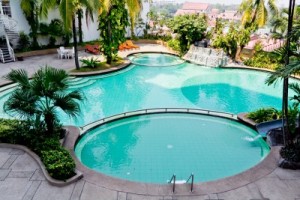Taking the Plunge Wisely
 There is no doubt that the decision to build a pool requires an analysis of your financial situation. It is an expensive proposition and then there are maintenance expenses as well as insurance and tax implications. Recouping your investment when you sell should most assuredly not be a part of the decision. While a pool may be attractive to some buyers, others might be put off by the upkeep or safety concerns. But if you are looking for the ultimate “staycation” location, there is nothing better than a pool in your backyard. As you contemplate the plunge, there are things that should be considered.
There is no doubt that the decision to build a pool requires an analysis of your financial situation. It is an expensive proposition and then there are maintenance expenses as well as insurance and tax implications. Recouping your investment when you sell should most assuredly not be a part of the decision. While a pool may be attractive to some buyers, others might be put off by the upkeep or safety concerns. But if you are looking for the ultimate “staycation” location, there is nothing better than a pool in your backyard. As you contemplate the plunge, there are things that should be considered.
The average cost in the United States to install, equip, and fill a 600-square-foot concrete pool starts at $30,000. Add in aesthetic details like waterfalls, lighting, landscaping, and perhaps a spa, and you are easily looking at significant dollars. Concrete is the most expensive pool material, but it is also the most durable and offers the most options for customization. Fiberglass shells and those with vinyl liners fall on the lower end of the budget scale, but the liners typically need replacing every 10 or so years.
The filtration pump is the biggest energy hog in a pool system, so you want to get the most efficient pump possible. The good news here is that new, variable-speed pumps use up to 80% less energy than old single-speed pumps, cutting operating expenses dramatically. You can further cut energy costs by setting the pump to run at non-peak times, when rates for electricity are lower. If you are planning to heat your pool, gas heaters are the least expensive to purchase and install, but they typically have the highest operation and maintenance costs. Many pool owners opt instead for electric heat pumps, which extract heat from the surrounding air and transfer it to the water. Heat pumps take longer than gas to warm the pool, but they are certainly more energy-efficient.
All pools require that the water be balanced for proper pH, alkalinity, and calcium levels. They also need sanitizing to control bacteria and germs, which is where chlorine has traditionally entered the picture. These days you have a variety of options, including systems that use bromine, salt, ozone, ionizers, or other chemical compounds that can be less irritating to skin. Chlorine remains the most popular because the upfront costs are reasonable, and you do not have to be as rigid about checking the levels on a set schedule. But as far as your wallet is concerned, they all even out in the end. To save yourself the task of once-a-week vacuuming, you can buy a robotic cleaning system.
You will need to purchase a homeowners insurance policy that covers the pool structure, but you should also increase your liability from the standard amount. Many underwriters require you to fence in the pool so that children can’t wander in unsupervised.
With the rising cost of gas, having a backyard oasis can trim vacation costs. There is nothing more relaxing than the view of a sparkling pool from your back window or back door. Entertaining occurs at any time of the day on any day of the week. All you need to purchase is a healthy supply of paper umbrellas for your pool drinks.
Source: Umberger, Mary. “Five Must Knows Before Buying a Pool.” www.InmanNews.com Web. 23 June 2013.
Call us today to view our new home plans: 713-539-0048 – Sign up for our New Home Buying Tips
Visit our website: https://fairmontcustomhomes.com/
View Our Communities – View our available new home floor plans – View our photo gallery
Follow Us: Facebook – Twitter – YouTube – LinkedIn – Google Plus


Sorry, the comment form is closed at this time.